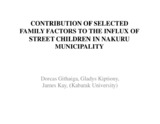CONTRIBUTION OF SELECTED FAMILY FACTORS TO THE INFLUX OF STREET CHILDREN IN NAKURU MUNICIPALITY
| dc.contributor.author | Githaiga, Dorcas | |
| dc.contributor.author | Kiptiony, Gladys | |
| dc.contributor.author | Kay, James | |
| dc.date.accessioned | 2021-08-06T06:02:00Z | |
| dc.date.available | 2021-08-06T06:02:00Z | |
| dc.date.issued | 2015 | |
| dc.identifier.uri | http://ir.kabarak.ac.ke/handle/123456789/703 | |
| dc.description.abstract | the presence of street children in Kenyan urban centers began in early 1950s (ANPPCAN, 1994) when the colonial government broke up families by taking men to concentration camps and encouraging others to migrate to urban areas for formal employment leaving women and children in the rural areas. In urban centers, there were few women who provided commercial sex. Single parenthood and the poor living conditions of these commercial sex workers seem to have produced the first lot of street children whose parents were taken to detention camps leaving them to become vagrants. | en_US |
| dc.language.iso | en | en_US |
| dc.publisher | Kabarak University | en_US |
| dc.subject | FAMILY FACTORS | en_US |
| dc.subject | STREET CHILDREN | en_US |
| dc.title | CONTRIBUTION OF SELECTED FAMILY FACTORS TO THE INFLUX OF STREET CHILDREN IN NAKURU MUNICIPALITY | en_US |
| dc.type | Presentation | en_US |

